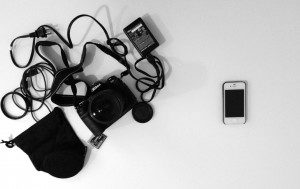Smartphones haven’t changed the rules of photojournalism
In 2012, American photojournalist Ben Lowy made history. His photograph of waves from Hurricane Sandy breaking in New York City made the cover of Time magazine; it was taken with an iPhone.
Lowy has taken his iPhone to other locales as well: he documented the Libyan conflict and also captured images in Kabul, Afghanistan for The New York Times. The iPhone is inconspicuous and portable, plus all the editing can be done on the same device.
But the iPhone has set many professional photographers to banging their heads against the wall—and it’s true that the smartphone can be cause for strife. It has made photography accessible to everyone, but also, it’s not hard to tell a professional from an amateur. When Kodak’s camera came out, it was a camera for the people: you press the button, we do the rest. Now the iPhone is a camera for the people. Annie Leibovitz calls it “the snapshot camera of today.”
And while it has been used for good, the iPhone has also been used for bad. The Chicago Sun-Times announced in May that it would be firing its entire photography department and instead, training reporters on iPhones. The strategy hasn’t been visually successful for them. Earlier this year, a French newspaper printed an issue with white squares in place of photos to show how much we require the visual medium to tell stories.
But it’s not the type of camera used that matters; it’s the person holding the camera and how he uses it. The best camera is the one you have in your hand. The arrival of the iPhone camera is like the introduction of medium-format film, 35mm film or digital cameras. It will take time to adapt to use it, but it’s just another machine that takes photos and another tool a photojournalist can use to tell a story.
In November, Hipstamatic—the app Lowy used for his Time magazine cover image—released an add-on for their app with Lowy’s help—a photojournalism-inspired lens that will offer images that have “a bit of contrast, and [are] slightly saturated. The highlights aren’t too blown out and the shadows aren’t too dark.”
As always, it’s up to photographers to be honest and transparent with the public about their images. Sure, they can use filters to alter photos easily on their phones, but this could also be done on a computer and in the dark room. The rules of photojournalism haven’t changed, just the tools used to accomplish the story.
Remember to follow the Review and its masthead on Twitter. Email the blog editor here.
Don’t miss Amelia Brown’s take on activist film critics, here.














